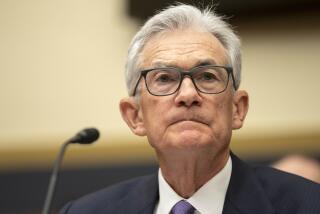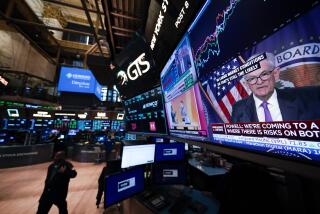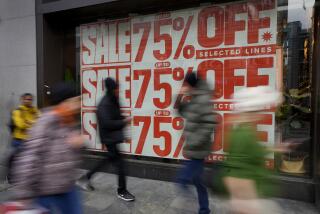Fed slashes rate to near zero to counter coronavirus as Fauci warns ‘worst is yet ahead’

The Federal Reserve slashed interest rates Sunday to nearly zero and predicted a significant hit to the U.S. economy as closures of businesses, schools and government facilities continued and health officials recommended canceling all upcoming events of 50 people or more.
Even so, President Trump painted a positive picture of the government’s efforts to stem the spread.
“This is a very contagious virus. It’s incredible,” Trump said at a White House briefing, flanked by members of his coronavirus task force. “But it’s something that we have tremendous control of.”
Anthony Fauci, the federal government’s most visible infectious diseases expert, was far more somber. “The worst is yet ahead for us,” he said.
Taking sweeping emergency measures to fight the coronavirus’ severe impact on markets, the Fed on Sunday slashed interest rates to near zero and said it would buy at least $700 billion of Treasury and mortgage-backed securities to help maintain smooth functioning of financial markets.
The Fed announced it would cut a full percentage point from its benchmark rate, taking it down to the same rock-bottom level where it was pinned for seven years until December 2015 because of the Great Recession and slow recovery from it.
Trump, who has made stock market and economic concerns a prime focus as he confronts the virus’ spread, said the rate cut “makes me very happy.”
The president also sought to calm panic consumer buying at supermarkets and drugstores, offering assurances that food supplies will not be disrupted as Americans cope with dizzying changes that have altered the rhythms of daily life across the country.
“You don’t have to buy so much,” he said after a conference call Sunday with the heads of the largest U.S. retail chains. “Take it easy — just relax.”
The moves came on a day in which state and local officials across the country ordered closure of schools, restaurants, bars and other areas where people might mingle and spread the virus, taking steps that even a few days ago were considered too drastic to contemplate.
The Centers for Disease Control and Prevention on Sunday recommended that for the next eight weeks, all in-person events consisting of 50 or more people — public and private — be canceled or postponed nationwide. The new guideline is expected to deliver another major blow to the economy.
Some economists say the increasing lockdown in the United States could lead to an even sharper contraction than during the Great Recession. “It’s not just a loss in activity. It’s a stop, full stop,” said Diane Swonk, chief economist at accounting firm Grant Thornton.
U.S. stock futures plunged after the Fed’s announcement and calls by the CDC for Americans to hunker down.
“The reality that the largest economy is about to shut down is overwhelming,” Swonk said.
In New York, Mayor Bill de Blasio ordered the city’s schools closed until at least April 20, a move he had resisted because of concern that thousands of students, especially those from low-income families, will be at risk and that many healthcare workers will have to stay home to take care of their children.
Governors in Ohio, Illinois and Arizona were among those who ordered closures. In Ohio, for example, Gov. Mike DeWine told all restaurants and bars in the state to close as of Sunday night.
“What we’ve done this week is drastic action, but we’re taking these steps to save lives. With no intervention we could expect 40%-70% of our population would contract this virus. We’ve made dramatic interventions to make a difference & stop our healthcare system from imploding,” he wrote on Twitter. He has been among the most aggressive governors in ordering closures in a state.
Fed Chairman Jerome H. Powell, in a hastily called news conference Sunday evening, said the virus was having “profound effect on people across the United States and around the world.”
“Economic policymakers must do what we can to ease hardship caused by these disruptions to the economy and support a swift return to normal once they’re passed,” he said.
The Fed also announced moves aimed at boosting lending, including lowering the rate charged to banks for short-term emergency loans, and said it would encourage banks to lend to households and businesses affected by the coronavirus.
Fed policymakers made an emergency half-point rate cut about two weeks ago and were set to meet Tuesday and Wednesday for a regularly scheduled meeting, when analysts expected more action to be taken. But officials did not wait.
“Desperate times call for desperate measures, and the Fed is doing just that in an effort to keep credit markets functioning and prevent the type of starving of credit that nearly toppled the global economy into a depression in 2008,” said Greg McBride, chief financial analyst at Bankrate.com.
“Reducing interest rates to borrowers will ease the burden of existing debts slightly,” he said, but he noted that is “unlikely to spur the usual surge of borrowing as consumers and businesses batten down the hatches for a coming drop-off in U.S. economic activity.”
Chris Rupkey, chief financial economist at MUFG Bank in New York, called the Fed move a “powerful response” that should do a lot to bolster confidence in world financial markets.
He said the emergency action was “quicker and of greater magnitude than almost any other time in history,” and as a result he worried that it could generate even more panic selling in the markets.
“The Fed has lowered the boom on interest rates today and time will tell whether this lessens the coming economic storm or limits the job layoffs that are surely coming now that many businesses have virtually shut the doors on their operations for the next 30 days,” Rupkey said.
With the United States lagging far behind many industrialized nations in testing for the novel virus, Vice President Mike Pence promised a ramped-up testing regimen to begin taking hold this week. Confirmed infections neared 4,000 in 49 states and the District of Columbia, but authorities have acknowledged the numbers are artificially low because so few people have been tested.
Fauci, who heads the National Institute of Allergy and Infectious Diseases at the National Institutes of Health, said drastic changes in the daily lives of many people were needed to prevent a spike of infections that could overwhelm the healthcare system.
Fauci hailed a “new phase” of testing efforts that should speed efforts to isolate and treat those infected. But he said the country was in a critical window for slowing the number of new cases through measures like social distancing.
Another key task force member, Deborah Birx, acknowledged there would be “pent-up demand” for tests because they have so far been in such short supply, with many people unable to obtain diagnostic treatment even if they are showing symptoms or know they have been exposed.
But Birx, the White House coordinator for the coronavirus response, said that even as tests become more widely available, the first slots would have to be devoted to healthcare workers and first responders so they could better help others.
“We ask you to prioritize them, and prioritize them in the lines,” she said.
Times staff writer David Lauter contributed to this report.







